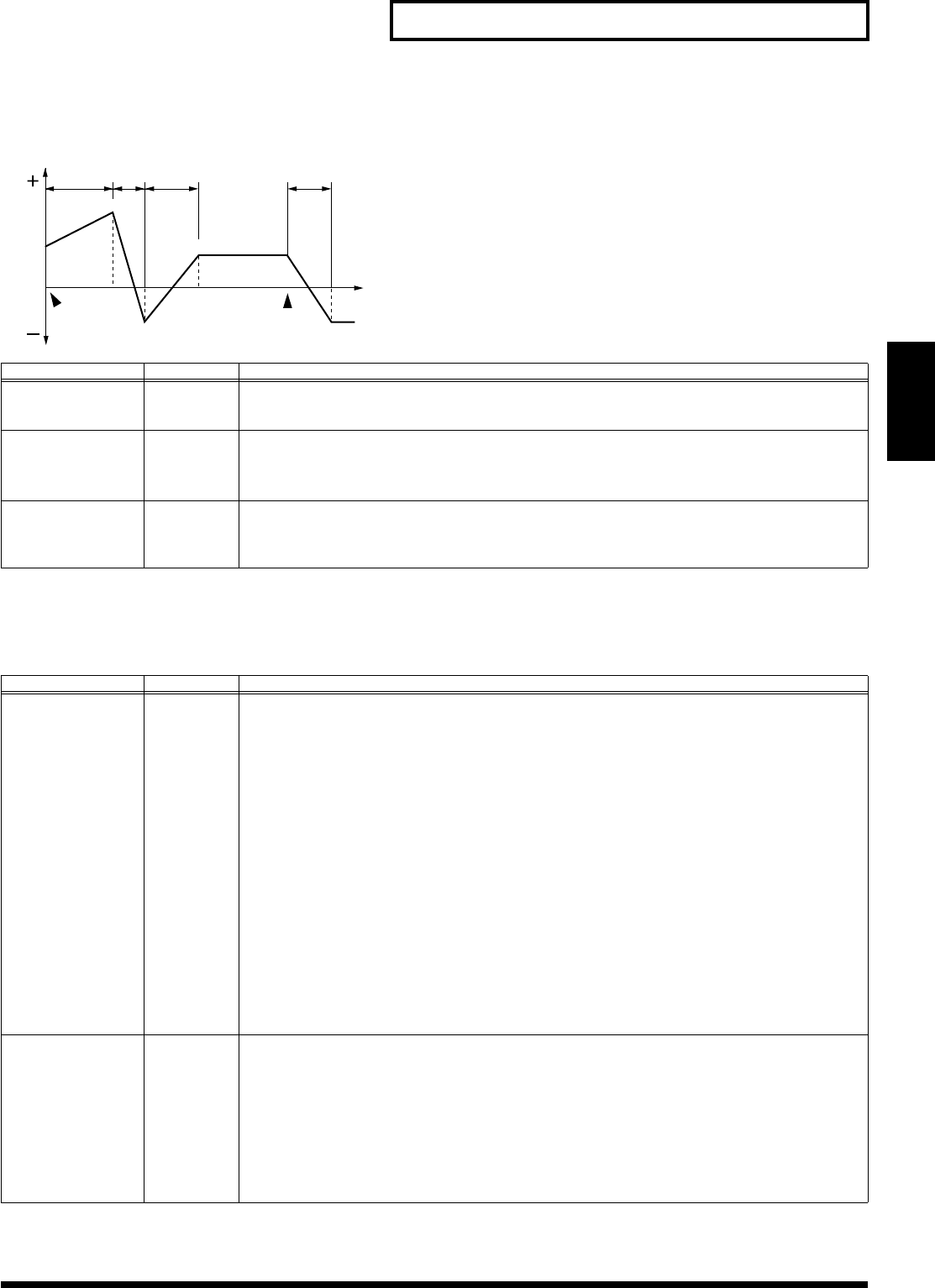
59
Patch Edit
Patch/Sample Mode
Pitch Env (Pitch Envelope)
These parameters specify the depth of the pitch envelope (the way in which pitch will change over time), and the shape of the envelope itself.
Filter
These parameters are settings for the TVF (Time Variant Filter). They modify the timbral character of the tone by adjusting the brightness and
fatness of the sound.
Parameter
Value Description
P-Env Depth #
-12– +12 Pitch envelope depth
Increasing this value will produce greater change. Negative (-) values will invert the change pro-
duced by the envelope.
P-Env Time1–4 # 0–127 Pitch envelope times (T1–T4)
Increasing this value will lengthen the time until the next pitch level is reached (for example, T2 is the
time over which the pitch will change from L1 to L2).
* Realtime modify knob [A] adjusts Time 1, and knob [D] adjusts Time 3.
P-Env Level0–4 -63– +63 Pitch envelope levels (L0–L4)
These parameters specify the amount by which the pitch will change from the basic pitch (specified
by Coarse Tune and Fine Tune) at each point of the envelope. Positive (+) values will raise the pitch
above the basic pitch, and negative (-) values will lower it.
Parameter
Value Description
Filter Type #
OFF, LPF,
BPF, HPF,
PKG, LPF2,
LPF3
Type of filter
A filter cuts a specific frequency region of the sound to modify the brightness or thickness of the
sound.
OFF:
A filter will not be used.
LPF:
Low Pass Filter. Cuts the region that lies above the cutoff frequency. The sound will become
more mellow as the high frequency region is cut. This is the most commonly used type of filter.
BPF:
Band Pass Filter. Leaves only the region in the vicinity of the cutoff frequency, and cuts the rest.
Suitable for creating sounds with a distinctive character.
HPF:
High Pass Filter. Cuts the region that lies below the cutoff frequency. Suitable for creating per-
cussion instrument sounds that have a distinctive high range.
PKG:
Peaking filter. Emphasizes the region in the vicinity of the cutoff frequency. You can create a
wah effect by using an LFO to cyclically modulate the cutoff frequency.
LPF2:
Low Pass Filter 2. Cuts the region that lies above the cutoff frequency. This lets you leave the
cutoff frequency fixed, and use the TVF envelope settings to vary the depth of the cutoff. Since this
does not impair the feeling of energy of the sound, it is effective for acoustic-type sounds.
* The resonance setting is ignored.
LPF3:
Low Pass Filter 3. Cuts the region that lies above the cutoff frequency. This filter cuts the high
frequency region more gently than LPF2. Since this does not impair the feeling of energy of the sound,
it is effective for acoustic-type sounds.
* The resonance setting is ignored.
Cutoff Frequency # 0–127 Frequency (cutoff frequency) at which the filter will begin affecting the frequency content of the wave-
form
If the Filter Type is LPF/LPF2/LPF3
, reducing the cutoff frequency will diminish the higher over-
tones, producing a more mellow sound. Raising the cutoff frequency will brighten the sound.
If the Filter Type is BPF
, the cutoff frequency value will change the harmonic content that will be
sounded. This is suitable for creating sounds with a distinctive character.
If the Filter Type is HPF
, raising the cutoff frequency will diminish the lower overtones, emphasiz-
ing only the bright portion of the sound.
If the Filter Type is PKG
, the cutoff frequency value will change the harmonic content that will be
boosted.
T1 T2 T3 T4
L3
L4
L2
L1
L0
Pitch
key is
pressed
key is
released
Time
MC-909_Ref_e.book 59 ページ 2005年3月1日 火曜日 午後3時29分


















